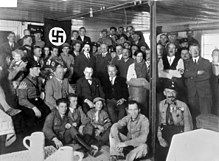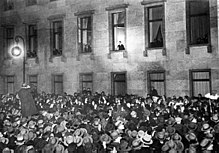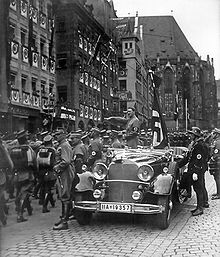Date | Votes | Percentage of Votes  | Seats in Reichstag  | Background |
|---|---|---|---|---|
| May 1924 | 1,918,300 | 6.5 | 32 | Hitler in prison |
| December 1924 | 907,300 | 3.0 | 14 | Hitler is released from prison |
| May 1928 | 810,100 | 2.6 | 12 | |
| September 1930 | 6,409,600 | 18.3 | 107 | After the financial crisis |
| July 1932 | 13,745,800 | 37.4 | 230 | After Hitler was candidate for presidency |
| November 1932 | 11,737,000 | 33.1 | 196 | |
| March 1933 | 17,277,000 | 43.9 | 288 | During Hitler's term as Chancellor of Germany |
Brüning Administration
The political turning point for Hitler came when the Great Depression hit Germany in 1930. The Weimar Republic had never been firmly rooted and was openly opposed by right-wing conservatives (including monarchists), communists and the Nazis. As the parties loyal to the democratic, parliamentary republic found themselves unable to agree on counter-measures, their grand coalition broke up and was replaced by a minority cabinet. The new Chancellor, Heinrich Brüning of the Roman Catholic Centre Party, lacking a majority in parliament, had to implement his measures through the president's emergency decrees. Tolerated by the majority of parties, this rule by decree would become the norm over a series of unworkable parliaments and paved the way for authoritarian forms of government.
The Reichstag's initial opposition to Brüning's measures led to premature elections in September 1930. The republican parties lost their majority and their ability to resume the grand coalition, while the Nazis suddenly rose from relative obscurity to win 18.3% of the vote along with 107 seats. In the process, they jumped from the ninth-smallest party in the chamber to the second largest.
In September–October 1930, Hitler appeared as a major defence witness at the trial in Leipzig of two junior Reichswehr officers charged with membership of the Nazi Party, which at that time was forbidden to Reichswehr personnel. The two officers, Leutnants Richard Scheringer and Hans Ludin, admitted quite openly to Nazi Party membership, and used as their defence that the Nazi Party membership should not be forbidden to those serving in the Reichswehr. When the Prosecution argued that the Nazi Party was a dangerous revolutionary force, one of the defence lawyers, Hans Frank had Hitler brought to the stand to prove that the Nazi Party was a law-abiding party. During his testimony, Hitler insisted that his party was determined to come to power legally, that the phrase "National Revolution" was only to be interpreted "politically", and that his Party was a friend, not an enemy of the Reichswehr. Hitler's testimony of 25 September 1930 won him many admirers within the ranks of the officer corps.
Brüning's measures of budget consolidation and financial austerity brought little economic improvement and were extremely unpopular. Under these circumstances, Hitler appealed to the bulk of German farmers, war veterans and the middle class, who had been hard-hit by both the inflation of the 1920s and the unemployment of the Depression.
In September 1931, Hitler's niece Geli Raubal was found dead in her bedroom in his Munich apartment (his half-sister Angela and her daughter Geli had been with him in Munich since 1929), an apparent suicide. Geli, who was believed to be in some sort of romantic relationship with Hitler, was 19 years younger than he was, and had used his gun. His niece's death is viewed as a source of deep, lasting pain for him.
In 1932, Hitler intended to run against the aging President Paul von Hindenburg in the scheduled presidential elections. His 27 January 1932 speech to the Industry Club in Düsseldorf won him, for the first time, support from a broad swath of Germany's most powerful industrialists. Though Hitler had left Austria in 1913 and had formally renounced his Austrian citizenship on 7 April 1925, he still had not acquired German citizenship and hence could not run for public office. For almost seven years Hitler was stateless and faced the risk of deportation from Germany. On 25 February 1932, however, the Nazi interior minister ofBrunswick (the Nazis were part of a right-wing coalition governing the state) appointed Hitler as administrator for the state's delegation to the Reichsrat in Berlin. This appointment made Hitler a citizen of Brunswick. In those days, the states conferred citizenship, so this automatically made Hitler a citizen of Germany as well and thus eligible to run for president.
The new German citizen ran against Hindenburg, who was supported by a broad range of nationalist, monarchist, Catholic, republican and even social democratic parties. Another candidate was a Communist and member of a fringe right-wing party. Hitler's campaign was called "Hitler über Deutschland" (Hitler over Germany). The name had a double meaning; besides a reference to his dictatorial ambitions, it referred to the fact that he campaigned by aircraft. Hitler came in second on both rounds, attaining more than 35% of the vote during the second one in April. Although he lost to Hindenburg, the election established Hitler as a realistic alternative in German politics.
Appointment as Chancellor
Meanwhile, Papen tried to get his revenge on Schleicher by working toward the General's downfall, through forming an intrigue with the camarilla and Alfred Hugenberg, media mogul and chairman of the DNVP. Also involved were Hjalmar Schacht, Fritz Thyssen and other leading German businessmen and international bankers. They financially supported the Nazi Party, which had been brought to the brink of bankruptcy by the cost of heavy campaigning. The businessmen wrote letters to Hindenburg, urging him to appoint Hitler as leader of a government "independent from parliamentary parties" which could turn into a movement that would "enrapture millions of people."
Finally, the president reluctantly agreed to appoint Hitler Chancellor of a coalition government formed by the NSDAP and DNVP. However, the Nazis were to be contained by a framework of conservative cabinet ministers, most notably by Papen as Vice-Chancellor and by Hugenberg as Minister of the Economy. The only other Nazi besides Hitler to get a portfolio was Wilhelm Frick, who was given the relatively powerless interior ministry (in Germany at the time, most powers wielded by the interior minister in other countries were held by the interior ministers of the states). As a concession to the Nazis, Göring was named minister without portfolio. While Papen intended to use Hitler as a figurehead, the Nazis gained key positions.
On the morning of 30 January 1933, in Hindenburg's office, Adolf Hitler was sworn in as Chancellor during what some observers later described as a brief and simple ceremony. His first speech as Chancellor took place on 10 February. The Nazis' seizure of power subsequently became known as the Machtergreifung orMachtübernahme.
Reichstag fire and the March elections
Having become Chancellor, Hitler foiled all attempts by his opponents to gain a majority in parliament. Because no single party could gain a majority, Hitler persuaded President Hindenburg to dissolve the Reichstag again. Elections were scheduled for early March, but on 27 February 1933, the Reichstag building was set on fire.Since a Dutch independent communist was found in the building, the fire was blamed on a communist plot. The government reacted with the Reichstag Fire Decree of 28 February which suspended basic rights, including habeas corpus. Under the provisions of this decree, the German Communist Party (KPD) and other groups were suppressed, and Communist functionaries and deputies were arrested, forced to flee, or murdered.
Campaigning continued, with the Nazis making use of paramilitary violence, anti-communist hysteria, and the government's resources for propaganda. On election day, 6 March, the NSDAP increased its result to 43.9% of the vote, remaining the largest party, but its victory was marred by its failure to secure an absolute majority, necessitating maintaining a coalition with the DNVP.
"Day of Potsdam" and the Enabling Act
On 21 March, the new Reichstag was constituted with an opening ceremony held at Potsdam's garrison church. This "Day of Potsdam" was staged to demonstrate reconciliation and unity between the revolutionary Nazi movement and "Old Prussia" with its elites and virtues. Hitler appeared in a tail coat and humbly greeted the aged President Hindenburg.
Because of the Nazis' failure to obtain a majority on their own, Hitler's government confronted the newly elected Reichstag with the Enabling Act that would have vested the cabinet with legislative powers for a period of four years. Though such a bill was not unprecedented, this act was different since it allowed for deviations from the constitution. Since the bill required a ⅔ majority in order to pass, the government needed the support of other parties. The position of the Centre Party, the third largest party in the Reichstag, turned out to be decisive: under the leadership of Ludwig Kaas, the party decided to vote for the Enabling Act. It did so in return for the government's oral guarantees regarding the Church's liberty, the concordats signed by German states and the continued existence of the Centre Party.On 21 March, the new Reichstag was constituted with an opening ceremony held at Potsdam's garrison church. This "Day of Potsdam" was staged to demonstrate reconciliation and unity between the revolutionary Nazi movement and "Old Prussia" with its elites and virtues. Hitler appeared in a tail coat and humbly greeted the aged President Hindenburg.
On 23 March, the Reichstag assembled in a replacement building under extremely turbulent circumstances. Some SA men served as guards within while large groups outside the building shouted slogans and threats toward the arriving deputies. Kaas announced that the Centre Party would support the bill with "concerns put aside," while Social Democrat Otto Wels denounced the act in his speech. At the end of the day, all parties except the Social Democrats voted in favour of the bill. The Communists, as well as some Social Democrats, were barred from attending. The Enabling Act, combined with the Reichstag Fire Decree, transformed Hitler's government into a legal dictatorship.
Removal of remaining limits
| “ | At the risk of appearing to talk nonsense I tell you that the Nazi movement will go on for 1,000 years! ... Don't forget how people laughed at me 15 years ago when I declared that one day I would govern Germany. They laugh now, just as foolishly, when I declare that I shall remain in power! | ” |
—Adolf Hitler to a British correspondent in Berlin, June 1934 | ||
With this combination of legislative and executive power, Hitler's government further suppressed the remaining political opposition. After the rapid dissolution of the Communist Party, the Social Democratic Party(SPD) was banned, leading to a 10 May court order that all property and assets be seized. The Steel Helmets (World War I veterans) on 26 April were placed under Hitler's leadership with a guarantee they would exist as an autonomous organization to be called upon as an auxiliary police force. On 2 May, stormtroopers ransacked and destroyed every trade union office in the country, and 4 May the Christian Trade Unions and all other unions vowed allegiance to Hitler. The State Party dissolved on 28 June. The 60 year old People's Party officially dissolved on 4 July. The Catholic Church was given no choice but to support Hitler after dissolution of their Centre Party on 5 July. The right wing German Nationalist Front was forced to incorporate its small paramilitaries into the Nazi SA and dissolved per the "Friendship Agreement". Finally, on 14 July, the Nazi Party was declared the only legal party in Germany as big business and the army stood on the sidelines.
Hitler used the SA paramilitary to push Hugenberg into resigning, and proceeded to politically isolate Vice-Chancellor Papen. Because the SA's demands for political and military power caused much anxiety among military and political leaders, Hitler used allegations of a plot by the SA leader Ernst Röhm to purge the SA's leadership during the Night of the Long Knives. As well, opponents unconnected with the SA were murdered, notably Gregor Strasser and former Chancellor Kurt von Schleicher.
President Paul von Hindenburg died on 2 August 1934. Rather than call new elections as required by the constitution, Hitler's cabinet proclaimed the presidency vacant and transferred the role and powers of the head of state to Hitler as Führer und Reichskanzler (leader and chancellor). This action was in accordance with a law passed the previousday, when it was apparent that Hindenburg was on his deathbed. effectively removed the last legal remedy by which Hitler could be dismissed – and with it, nearly all institutional checks and balances on his power. This action technically violated both the constitution and the Enabling Act. The constitution had been amended in 1932 to make the president of the High Court of Justice, not the chancellor, acting president until new elections could be held. The Enabling Act specifically barred Hitler from taking any action that tampered with the presidency. However, no one dared object.
On 19 August a plebiscite approved the merger of the presidency with the chancellorship with 84.6% of the electorate.
As head of state, Hitler now became Supreme Commander of the armed forces. When it came time for the soldiers and sailors to swear the traditional loyalty oath, it had been altered into an oath of personal loyalty to Hitler. Normally, soldiers and sailors swear loyalty to the holder of the office of supreme commander/commander-in-chief, not a specific person.
In 1938, two scandals resulted in Hitler bringing the Armed Forces under his control. Hitler forced the resignation of his War Minister (formerly Defense Minister), Werner von Blomberg, after evidence surfaced that Blomberg's new wife had a criminal past. Prior to removing Blomberg, Hitler and his clique removed army commander Werner von Fritsch on suspicion of homosexuality. Hitler replaced the Ministry of War with the Oberkommando der Wehrmacht (High Command of the Armed Forces, or OKW), headed by the pliant General Wilhelm Keitel. More importantly, Hitler announced he was assuming personal command of the armed forces. He took over Blomberg's other old post, that of Commander-in-Chief of the Armed Forces, for himself. He was already Supreme Commander by virtue of holding the powers of the president. The next day, the newspapers announced, "Strongest concentration of powers in Führer's hands!"




No comments:
Post a Comment